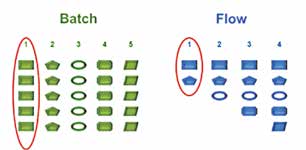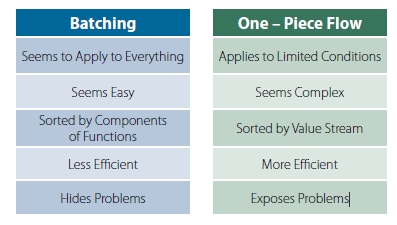By Dr. Sami Bahri
How production methods shape your group practice

According to literature, if you want to produce anything, there are two methods you can use. (Figure 1). Both methods apply to dentistry, but one is perceived to be almost four times more productive than the other.
Historically, the first method, “batch and queue,” surfaced in the beginning of the 20th century. It relies on breaking down a product or service into components. Each component is created in a dedicated area, by a dedicated function. In dentistry, this would look like making an appointment for composite fillings, a separate appointment for veneers, and in a separate area, a hygiene appointment.
The second way of doing things, one-piece flow, is based on producing all the pieces that belong to one product (the mouth, in our case) and assembling them as soon as they are produced, until the product is totally formed. Quadrant dentistry could represent the first step toward one-piece flow. When taken to its full extent, however, one-piece flow goes beyond quadrant dentistry to treat all quadrants in one sitting. Although that is not always possible, the more procedures we add to the flow, the more productive our practice.
One-piece flow is more productive than batch and queue. However, until we learn how to do it, one-piece flow is more complicated to apply. After we learn it, it becomes very simple, but until then, do we keep practicing in a batch and queue mode because we’re used to it, or do we step out of our comfort zone and learn flow because it is more productive? The answer is certainly personal.
|
Figure 1 The only known production system to date. |
Two different approaches to management and leadership
The space of this article would not allow to describe the details of the two production systems. Instead, we aim at describing a more profound issue: How each of the production systems affects your management and leadership style. (See Figure 2)
Batching
Batching seems easy because we divide the functions in a logical hierarchy: hygienists will do hygiene work, assistants, assistant work and dentists, dentist work. Patients come to hygiene appointments separately from dentistry appointments. Functions are specialized, such as treatment plan coordinator, appointment coordinator etc. If tasks become more complex we can divide the work further and hire more people. Batching seems to apply to everything from simple to complex situations. The problem with batching is that, as experience shows, it is less productive than one-piece flow. Again, do we stick with what we know because it is comfortable? Or, do we stretch our comfort zone and learn a more productive way?
Figure 2 Two different production systems require two different leadership styles
In an ideal world where one-piece flow would be totally possible, the whole treatment is finished in one sitting. In the real world, however, you will find that at the beginning, one-piece flow applies to a limited number of conditions like simple cleanings or simple fillings. Then, if you want to apply it to more complex conditions, as you should, the requirements become increasingly complex. That is probably why, managers have not been able to figure out how to apply it. I am as guilty of abandoning it as any other manager. Back in 1984, I tried to apply one-piece flow to dentistry, and was so discouraged by its complexity that I gave up. Then in 1996, some 12 years later, when I read lean thinking, I realized that a group of Toyota engineers had spent 20 years going through the maze of obstacles and solutions until they figured it out. Their results were so groundbreaking – their system is at least four times more productive than batch and queue – that I spent the next 10 years studying the system until I was able to apply to dentistry.
The differences between batch and lean leadership
 In batch and queue, we think that by breaking systems down into easy-to-understand, smaller pieces, we gain more control over our work. We keep perfecting the model, and in a way, dictate to our employees, new and improved methods. In this model, managers think and employees execute. We think that the closer employees conform to the standards we establish, the better the results – quality, cost, safety, and timely delivery. Unfortunately, in many cases employees are not supposed to think or help improve the way things are done.
In batch and queue, we think that by breaking systems down into easy-to-understand, smaller pieces, we gain more control over our work. We keep perfecting the model, and in a way, dictate to our employees, new and improved methods. In this model, managers think and employees execute. We think that the closer employees conform to the standards we establish, the better the results – quality, cost, safety, and timely delivery. Unfortunately, in many cases employees are not supposed to think or help improve the way things are done.
In flow management, mangers know that applying “One-piece flow” is like navigating in uncharted territory. It will uncover many problems along the way. We do not know what problems we will face and we are aware that, when confronted with the problems, we do not know how to solve them without further investigation. In contrast with the batch model, lean managers approach work from a learner’s perspective. In batch management, the manager owns the questions and their answers. In flow management, the managers have the right questions. The answers will come from the common experience of the whole team. If you want to include the patient, the solution would be even better.
The flow management approach has many advantages. It engages managers and employees in a constant dialog, allowing to build a coherent team. The learning perspective encourages mutual respect. But the most significant gain is the utilization of everyone’s intelligence, an invaluable asset, to improve every aspect of the business.



